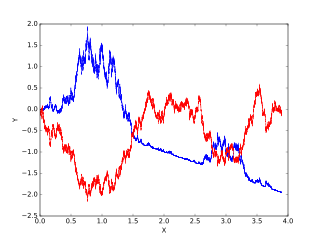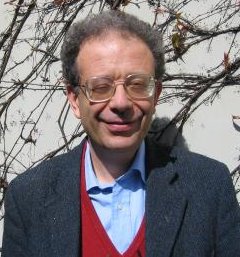Stochastic calculus is a branch of mathematics that operates on stochastic processes. It allows a consistent theory of integration to be defined for integrals of stochastic processes with respect to stochastic processes. This field was created and started by the Japanese mathematician Kiyosi Itô during World War II.
In probability theory and related fields, Malliavin calculus is a set of mathematical techniques and ideas that extend the mathematical field of calculus of variations from deterministic functions to stochastic processes. In particular, it allows the computation of derivatives of random variables. Malliavin calculus is also called the stochastic calculus of variations. P. Malliavin first initiated the calculus on infinite dimensional space. Then, the significant contributors such as S. Kusuoka, D. Stroock, J-M. Bismut, S. Watanabe, I. Shigekawa, and so on finally completed the foundations.
A stochastic differential equation (SDE) is a differential equation in which one or more of the terms is a stochastic process, resulting in a solution which is also a stochastic process. SDEs have many applications throughout pure mathematics and are used to model various behaviours of stochastic models such as stock prices, random growth models or physical systems that are subjected to thermal fluctuations.

Itô calculus, named after Kiyosi Itô, extends the methods of calculus to stochastic processes such as Brownian motion. It has important applications in mathematical finance and stochastic differential equations.
In signal processing, a nonlinearfilter is a filter whose output is not a linear function of its input. That is, if the filter outputs signals R and S for two input signals r and s separately, but does not always output αR + βS when the input is a linear combination αr + βs.
In stochastic processes, the Stratonovich integral or Fisk–Stratonovich integral is a stochastic integral, the most common alternative to the Itô integral. Although the Itô integral is the usual choice in applied mathematics, the Stratonovich integral is frequently used in physics.
In mathematics, the Clark–Ocone theorem is a theorem of stochastic analysis. It expresses the value of some function F defined on the classical Wiener space of continuous paths starting at the origin as the sum of its mean value and an Itô integral with respect to that path. It is named after the contributions of mathematicians J.M.C. Clark (1970), Daniel Ocone (1984) and U.G. Haussmann (1978).
In filtering theory the Zakai equation is a linear stochastic partial differential equation for the un-normalized density of a hidden state. In contrast, the Kushner equation gives a non-linear stochastic partial differential equation for the normalized density of the hidden state. In principle either approach allows one to estimate a quantity function from noisy measurements, even when the system is non-linear. The application of this approach to a specific engineering situation may be problematic however, as these equations are quite complex. The Zakai equation is a bilinear stochastic partial differential equation. It was named after Moshe Zakai.

Paul Malliavin was a French mathematician who made important contributions to harmonic analysis and stochastic analysis. He is known for the Malliavin calculus, an infinite dimensional calculus for functionals on the Wiener space and his probabilistic proof of Hörmander's theorem. He was Professor at the Pierre and Marie Curie University and a member of the French Academy of Sciences from 1979 to 2010.
In the theory of stochastic processes, filtering describes the problem of determining the state of a system from an incomplete and potentially noisy set of observations. While originally motivated by problems in engineering, filtering found applications in many fields from signal processing to finance.
Stochastic partial differential equations (SPDEs) generalize partial differential equations via random force terms and coefficients, in the same way ordinary stochastic differential equations generalize ordinary differential equations.
Václav Edvard "Vic" Beneš is a Czech-American, a mathematician known for his contributions to the theory of stochastic processes, queueing theory and control theory, as well as the design of telecommunications switches.
In mathematics, the Skorokhod integral, often denoted , is an operator of great importance in the theory of stochastic processes. It is named after the Ukrainian mathematician Anatoliy Skorokhod and japanese mathematician Masuyuki Hitsuda. Part of its importance is that it unifies several concepts:

Jean-Michel Bismut is a French mathematician who has been a professor at the Université Paris-Sud since 1981. His mathematical career covers two apparently different branches of mathematics: probability theory and differential geometry. Ideas from probability play an important role in his works on geometry.
This page lists articles related to probability theory. In particular, it lists many articles corresponding to specific probability distributions. Such articles are marked here by a code of the form (X:Y), which refers to number of random variables involved and the type of the distribution. For example (2:DC) indicates a distribution with two random variables, discrete or continuous. Other codes are just abbreviations for topics. The list of codes can be found in the table of contents.
In filtering theory the Kushner equation is an equation for the conditional probability density of the state of a stochastic non-linear dynamical system, given noisy measurements of the state. It therefore provides the solution of the nonlinear filtering problem in estimation theory. The equation is sometimes referred to as the Stratonovich–Kushnerequation. However, the correct equation in terms of Itō calculus was first derived by Kushner although a more heuristic Stratonovich version of it appeared already in Stratonovich's works in late fifties. However, the derivation in terms of Itō calculus is due to Richard Bucy.
David Nualart is a Spanish mathematician working in the field of probability theory, in particular on aspects of stochastic processes and stochastic analysis.
In stochastic calculus, the Ogawa integral is a stochastic integral for non-adapted processes as integrands. The corresponding calculus is called non-causal calculus in order to distinguish it from the anticipating calculus of the Skorokhod integral. The term causality refers to the adaptation to the natural filtration of the integrator.
In probability theory, Lévy's stochastic area is a stochastic process that describes the enclosed area of a trajectory of a two-dimensional Brownian motion and its chord. The process was introduced by Paul Lévy in 1940, and in 1950 he computed the characteristic function and conditional characteristic function.



